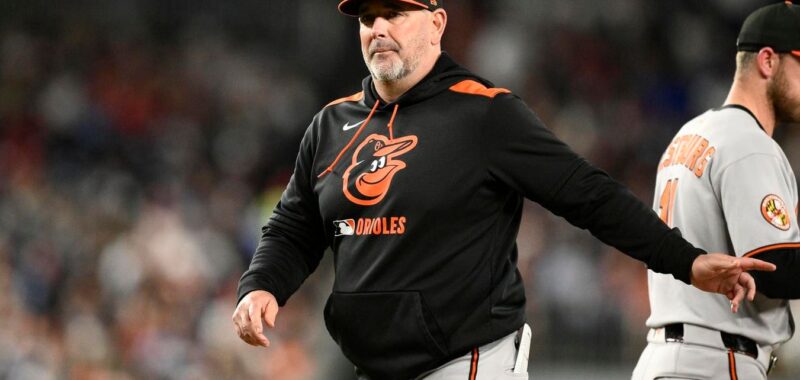Baltimore Orioles manager Brandon Hyde (18) in action during a baseball game against the Washington … More
The Baltimore Orioles parted ways with manager Brandon Hyde on Saturday following a 15-28 start to the season. He became the third MLB manager to lose his job this year, along with Bud Black and Derek Shelton, formerly of the Colorado Rockies and Pittsburgh Pirates.
This is the first time three managers have been fired before June since 2002. Obviously, none of their former ballclubs have met expectations, but the managers don’t deserve all of the blame for the losing seasons. Other than their newfound free time, the three of them all have something in common: they were set up to fail by inadequate offseason roster-building.
Baltimore Orioles
The Orioles went 54-108, 25-35, and 54-110 in Hyde’s first three years at the helm, then 83-79, 101-61, and 91-71 from 2022-2024. Their young core of hitters including Gunnar Henderson, Adley Rutchsman, and Jackson Holliday is the envy of baseball, and they were expected to continue their winning ways in 2025.
However, the front office should’ve known their starting pitching depth was thin heading into the season. Kyle Bradish and Tyler Wells both underwent elbow surgery last June and are expected to miss most, if not all, of the 2025 campaign, and they lost ace Corbin Burnes in free agency. This was exacerbated when Grayson Rodriguez was shut down with an elbow problem this spring.
Instead of bolstering the rotation this winter, the club focused on outfielders, acquiring Dylan Carlson, Ramón Laureano, and Tyler O’Neill. This curtailed pathways to playing time for their younger players and prospects, but the bigger problem is that it ignored their dearth of pitching.
They replaced Burnes with 35-year-old Japanese starter Tomoyuki Sugano, and rolled the dice with Kyle Gibson, who has since been designated for assignment. Their current rotation is Zach Eflin, Dean Kremer, Cade Povich, Sugano, and the void Gibson left behind. Collectively, Baltimore’s starting pitchers have a 5.83 ERA, which is more than a full run worse than any other American League team’s, and their 17.0% strikeout rate is the second-worst in MLB.
Colorado Rockies
The Rockies don’t have the recent track record of success that the Orioles have, but their pitching staff makes Baltimore’s look like the 1990s Braves. Their starters have a ghastly ERA of 7.19, and they have only struck out 14.4% of opposing hitters. They were 7-33 when they fired Black, two days after a 21-0 defeat at home, and they’re 8-37 now. No other MLB team has fewer than 14 wins.
With a roster this inept, the greatest manager in baseball history couldn’t have saved the Rockies. They’ve been outscored 295-152 this year. Despite the state of their team, the Colorado front office neglected to sign any players of significance this winter.
The largest contract they handed out was a one-year, $4 million guarantee to infielder Thairo Estrada, who had been non-tendered by the San Francisco Giants. He’s currently on the injured list with a fractured wrist. The only major leaguer they acquired in a trade was utilityman Tyler Freeman.
Pittsburgh Pirates
This was Shelton’s sixth year managing the Pirates, and the best seasons they had together were a pair of 76-86 finishes in 2023 and 2024. They parted ways with him after a 12-26 start this season.
Unlike the Orioles and Rockies, pitching hasn’t been a major problem. In fact, they’re led by Paul Skenes, the top young pitcher in the game, who won the Rookie of the Year and started the All-Star Game last season. They’ve gotten solid performances from fellow starters Bailey Falter, Andrew Heaney, and Mitch Keller, and they have an adequate bullpen. They also have a handful of well-regarded pitching prospects in Triple-A.
A generational talent like Skenes is exactly the kind of player a franchise should build around, but the Pirates failed to piece together a sufficient lineup. They’re last in MLB in runs scored with 141, averaging just 3.1 runs per game. Their biggest position player acquisition of the offseason was Spencer Horwitz, who was injured all year until he was activated on Saturday. They didn’t sign anyone for more than $5 million and handed out no multiyear deals.
The Pirates have never had a $100 million team payroll in their history. It’s hard to say they’re waiting for the right time to invest in their roster, because with their wealth of young pitching, the time is now. Instead, they let the lineup languish, and Shelton paid the price.
It’s a similar story in Baltimore and Colorado. None of them made the necessary moves this offseason to build a contender. Their former managers took the blame, but their replacements aren’t likely to fare any better until their rosters improve.

